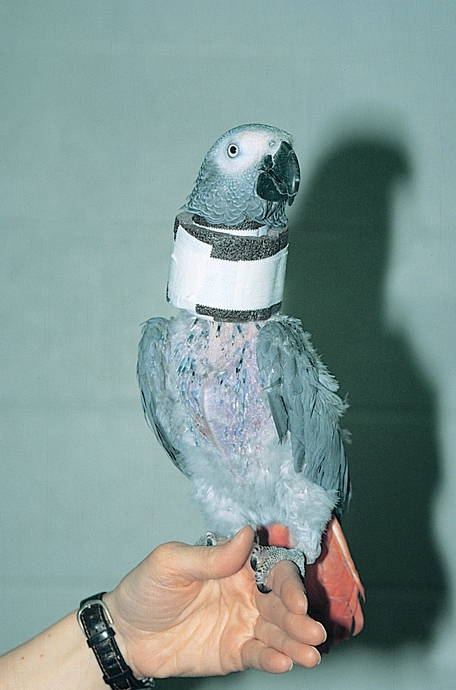Avian Medicine Q&A 04
| This question was provided by Manson Publishing as part of the OVAL Project. See more Avian Medicine questions |
‘Pattern picking’ – this parrot has normal head feathers whilst only down feathers remain on the body. This is a clinically normal bird in all respects except for its plumage; all blood parameters are normal. Bacterial, fungal, parasitic, viral, chlamydial and metabolic aetiologies for feather plucking have been ruled out. The feathers on the head are totally normal. This bird was hand-reared and is now only 2 years old. The picking has been ongoing for 1 year. On occasion, during intimate ‘cuddling sessions’, the bird regurgitates on the owner. The bird only picks in the presence of the owner.
| Question | Answer | Article | |
| What is the likely cause of the picking? | Reproductive hormonal pressure – sexual frustration – often begins to cause picking in young birds that are bonded to their owner even before reaching what is thought to be natural reproductive age.
The hormonal drive provides a natural incentive for the young bird to try to achieve a status in the dominance hierarchy of the flock. This will lead to success in obtaining a mate, holding territory and having access to adequate food, so that it is able to reproduce. Captive birds often mature earlier than wild birds, especially when the owner is providing all the necessary advantages as well as stimulating it with a close bond. Consequently the bird reaches reproductive maturity but the ‘mate’ is not responding in the manner that will result in the production of offspring. This often leads to ‘displacement behaviour’ such as feather picking, screaming or aggression. |
Link to Article | |
| What are some of the treatment options? | Some success has been achieved with the administration of progesterones to decrease the hormonal pressure but some treated birds become obese, suffer from polyuria/polydipsia, diabetes mellitus or develop hepatic lipidosis.
Recently, human chorionic gonadotrophin (HCG) (500–1000 IU kg-1 i.m.) has shown promise in providing effective, short-term resolution, especially in African grey parrots and cockatoo hens. There have been no reports of adverse reactions with this treatment but it is not always reliable. Tranquillizing agents – such as haloperidol – and psychotropic agents – such as clomipramine and Prozac – have shown some limited effectiveness in some individual cases. These medications can only provide a temporary solution and should be used in combination with behaviour modification techniques and changes in the bird’s environment to provide a more reliable response. Petting on the bird’s back and intimate cuddling should be reduced or eliminated. For the owner to assert dominance the bird should be maintained below human chest height. The cage may be moved to a location away from the main traffic area to reduce the anxiety of seeing the owner without being cuddled. The length of the day may be shortened by covering the cage earlier in the evening and, in the case of females, surgical removal of the oviduct may provide the best long-term solution. In some cases, the picking becomes a habit, even though the original cause is resolved and long-term, anti-compulsive medication may be indicated. |
Link to Article | |
